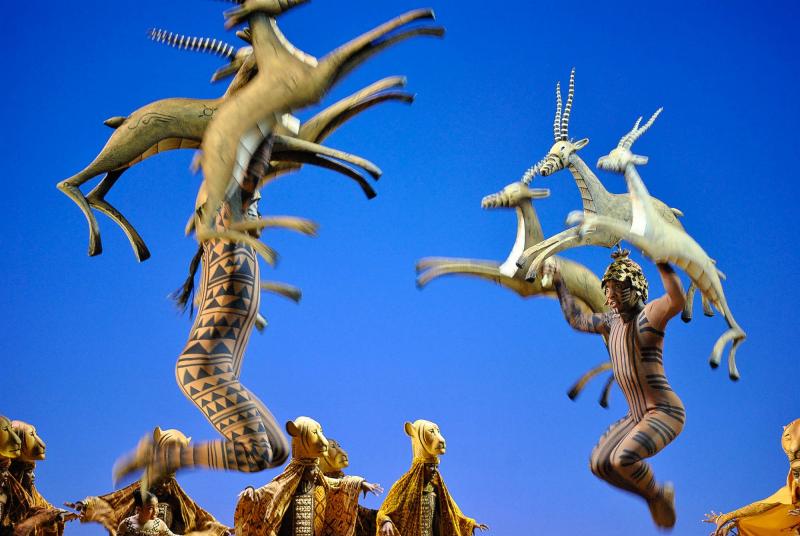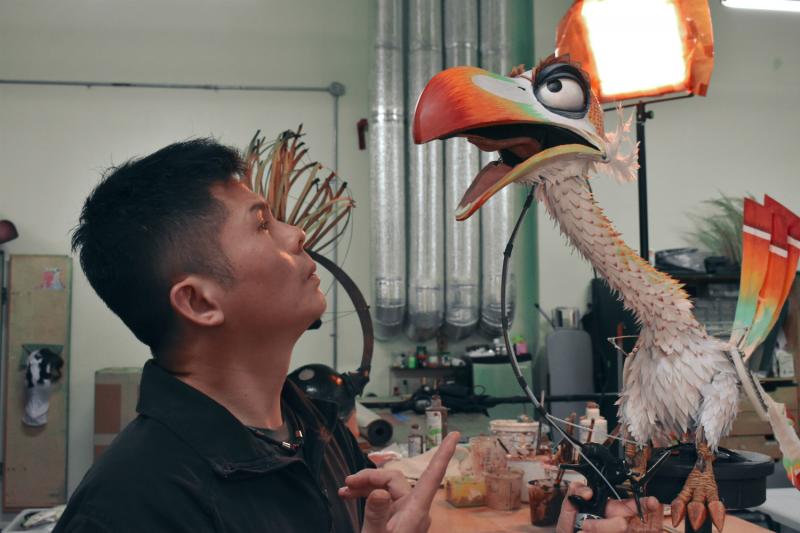Interview: Tim Lucas Talks Behind-the-Scenes With THE LION KING Puppets

Tim Lucas (Head of the Puppet Department) with Simba Masks and Mufasa Mask
Manila, Philippines--Based on the classic 1994 Disney animated film, "The Lion King" has been a hit around the world since its Broadway debut in 1997; it is now the third longest-running Broadway show in New York City. Played in over 100 cities in 19 countries, "The Lion King" ventures into its first international tour, which opened in Manila, Philippines, last month, with the tour's next stops to Singapore (June 2018), South Korea (November 2018), Taiwan, South Africa, and more countries to be announced.
"The Lion King" tells the story of Simba, a young lion who is to succeed his father as the King of the Pride Lands--mixed with the themes of family, friendship, love, and betrayal. As per the Director of International Strategy for Disney Theatrical Group Felipe Gamba, "The Lion King" "is a story of people, an allegory, wherein the animals are the vehicle to tell the story."
Director Julie Taymor made the importance of having the animals, which play a big part in the story, represented through costumes, masks, and puppets when it was first being put to the stage in 1997. Taymor also devised a concept to theatrically represent the story and heart of show on stage with what she called the "double event." The double event is the representation of the animals through the costumes, puppets, and masks, but still having the human or the actor visible to the audience.
Associate Director of the International Tour of "The Lion King" Anthony Lyn explains that having Taymor's concept of the double event, the show gets to represent the animals through the movement and style while also showing the human side, feelings, and emotions of the animals in the story. "The movement, the sensuality, the animalistic quality of the dancer is dictated through the puppet, and the puppet is dictated too by the quality of the dancer, expressing the emotions of the animal because the audience could see the face of the actor the whole time."

The puppets also create the illusion of a herd of animals, just like the visualization of the herd of gazelles by having puppets on the head and one on each of the arm of the actors. The actor does not just represent one but three gazelles. Consequently, the audience gets to see a herd of 15 gazelles played by five actors synchronously.
Taymor also designed some of the puppets to represent both the animal and human side and to transform to a full animal character. This is seen through the characters of Scar and Mufasa where the actors wear their masks on top of their heads to depict the double event. Here, Taymor devised their masks to have a mechanism that would allow the mask to swoop down to the front of the actors' faces, symbolizing the character becoming fully animal.
"The Lion King" features 25 kinds of animals, including birds, fishes, and insects. There are roughly 235 puppets in the show ranging from masks, full body suit puppets, and full-sized puppets from small animals to an elephant puppet that is operated by four actors. The masks and puppets are designed by Michael Curry and co-designed by Taymor. The puppets seen nowadays in the different production of "The Lion King" are made by Paragon Innovations, which has secured the contract to build most of the puppets with Curry supervising and giving a few inputs on certain details.
Out of the 134 people directly involved in the daily running of the International Tour of "The Lion King" are three talented people leading the puppet department. Tim Lucas heads the puppet department with his assistants, Mary-Ann Hia and Blue Xu. They make sure the concepts and designs of Curry and Taymor run and look smooth day in, day out, show after show as it tours around Asia and South Africa.
Lucas shares with BroadwayWorld.com the daily tasks they do to make sure the puppets of "The Lion King" runs a successful show here in Manila and for the rest of the tour.
What are your pre-show and post-show process?
For pre-show, we do a pre-show check where we walk around the theatre and check every puppet that is being used. We make sure that every puppet is fixed up and painted, that there are no cracks or breaks. We make sure that all the puppets are ready to be used safely and they look good. We usually go in two hours before the show to do our pre-show check. Sometimes, we go a lot earlier to do the fixtures for some breaks that happened the night before or test the mechanisms that run the system of a lot of the puppets.
After the show, we would go through a list of problems we saw or heard throughout the show, in some cases breakage that happened on stage or if a puppet cracks, falls, or breaks during the show. For days that have two shows, we do pre-show checks in the morning and then set it up. When the show runs, we'll do our standard maintenance work, do whatever that needs to be fixed. When the show ends, we grab dinner, then we do our pre-show check again, and the show runs again.
How do you manage to make sure that all the puppets are working and in good condition for the show and during the show?
While the show runs, everything is safe to use. We don't usually have tracks during the show; everything would be done in our workshop room downstairs before the show. We usually are on standby for any issues that happen to any puppet during the show, so we could run upstairs and fix it. If a principal puppet has any problems or issues during the show, we would have them use the spare puppet. Sometimes, we would be downstairs in our workshop room doing repairs for some puppets that require chemicals that need to dry overnight so we have to repair it quickly during the show.
What are the 5 things the puppet department can't live without?
A pair of pliers, a hex key tool that controls pretty much every screw or bolt of the puppet, duct tape, string, and epoxy. The first two tools are used for a lot of things for the puppets, from screwing to digging up stuff inside the puppet. We use epoxy to fill up any gaps or cracks in the puppet. And then we use duct tape and string for emergency fixes.
If anything happens like a break during a show, it has to be fixed really quickly so that they could still go out throughout the show. You can't stop a production just to fix something. So, these are the few things we have to make sure so that everything can run as safely as possible until the show is over.

How is the touring process different and similar to the process that is on Broadway or other places where they have 'The Lion King' permanently?
On Broadway or places where they have the show permanently, they tend to have more space, which means they are more comfortable with what they have and they can have more spares, more supplies to keep the production running. For the touring company, weight is always an issue so we tend to keep what we can. They will help us with the traveling and the fact that the stuff has to be packed up really quickly for the load off to get to the country safely. They're similar in the sense that every puppet is the same size. It's just that we have more packing to do and we are limited to weight in terms of what we can carry. We can't have a lot of spares.
The numbers of puppets are the same?
Yes, well maybe they have one or two more. Some productions might have a puppet that is really old and they brought a new one in, so they might have two Pumbaas, whereas we have one. So, they might have a little bit more puppets. They might have something that might be a little bit old but fixed quite easy, so they still like using it. They have a spare that they keep in the background for worst-case scenarios.
Since the touring company has only one Pumbaa, what if the Pumbaa breaks in the middle of the show?
We'll fix it. Pumbaa has never been not on stage, to my knowledge, even with a break. Whatever happens on stage, we have to fix it. It has to go out as a full puppet, which means if we have to do crazy work within one minute or 30 seconds, we'll do it so that he can go out and perform as much as he can. As long as the whole look of the production is there, our job is pretty much done. Then we'll worry about the fix after the show. That's why we come a little bit earlier and do the fixes.
We also have spares for certain things that tend to break. With the experience that the show has been running for the past few years, there are certain things that we know that tend to break a lot more, so we carry spares of those, like little parts, the spine, padding, or harnesses.
How is it like working for the International Tour of 'The Lion King'?
It's fun, a little bit tiring at times. We enjoy the work we do, it may seem a little bit day-in, day-out the same thing but we encounter different things, meet different people, we travel quite a bit. It's always fun. If you do shows like these, you need to enjoy what you do. If you love the work, then pretty much that's what it's all about. You can have fun with the people you work with. I'm having a blast.
Disney's "The Lion King" extends its run in Manila until May 20, 2018, at The Theatre at Solaire (Entertainment City, Aseana Avenue, Parañaque City).
Get tickets from TicketWorld.com.ph.
Photos: Janine Angela Martinez, Oliver Oliveros

Videos

